
Resonant events in the world in recent years, in particular, the revolutionary change of government and armed conflicts in countries of North Africa, the Middle East and the former Soviet Union confirm the appearance of new forms and methods to which the leading states resort in an attempt to achieve their foreign policy goals and to resolve interstate conflicts.
Thus, instead of classic military aggressions with the use of armed force there come the so-called “hybrid wars”. With their hidden nature, they are observed mainly in the political, economic, informational, and special spheres. For resolving specific tasks are involved small numbers of troops. The essence of this approach is to shift the center of efforts from physical destruction of the enemy within a large-scale war, to the use of means of “soft power” against the country of the enemy aiming at disintegration and change of its leadership, and including it into the sphere of (the aggressor country's) influence.
1. Reasons and peculiarities of "hybrid wars"
Characteristic features of “hybrid wars” are as follows: aggression, without formal declaration of war; concealment by the aggressor country of its participation in the conflict; wide use of irregular armed formations (including under cover of civilian population); ignoring (by the aggressor) of international rules of warfare, existing agreements and the agreements reached; mutual events of political and economic pressure (with the formal preservation of ties between the two countries); extensive propaganda and counter-propaganda by using “dirty” information technologies; attacks in cyberspace.
Today the topic of “hybrid wars” is already widely covered in the media, and it is the subject to special studies. In particular, these studies were conducted by renowned experts of world level, including Frank Hoffmann, Daniel Lasic, George Davis and Daviz Kilkallen (USA), Frank van Kappen (Netherlands).
As Russia has unleashed the military aggression against Ukraine, there is a need to study this topic, some generalization of the existing findings and assessments, while taking into consideration new factors and forecasts in the actions of the Russian Federation towards our state and the former USSR' countries of democratic choice.
From this, you can start with reasons for coming into existence of the very concept of “hybrid wars” and try to answer the question why different countries resort to exactly such warfare in order to achieve their goals.
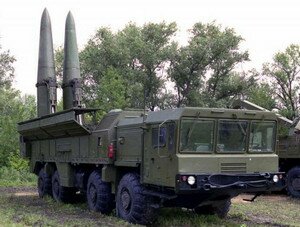 |
|
The main reason for the emergence of the very concept of "hybrid wars" is the emergence of new powerful weapons In the photo - the missile system "Iskander-M" |
The main reason for this is new kinds of powerful weapons (of massive weapons included), with which classic wars become extremely dangerous for both the aggressor and for the world. After all, it causes great casualties among the civilian population, provokes the emergence of large-scale refugee flows, disruption of transport and industrial infrastructure (including critically dangerous nuclear and chemical facilities), severance of existing economic and trade ties, etc.
An equally important factor is the aggressor's wish to downplay its role in launching conflicts in order to avoid sanctions imposed by other countries and international organizations, as well as not to lose its credibility and position in the world arena.
Another reason for avoiding a large-scale use of military force is the desire of the aggressor nations to establish their control over the objects of aggression (making the latter integrate into aggressors' political, economic and security systems) without causing them significant losses, which may affect the implementation of geopolitical and economic interests.
At the same time, the use of the principles of the “hybrid war” implies the existence or creation of certain mandatory prerequisites, internal and external.
Within the framework of such prerequisites, the aggressor country has to have a strong and effective government, which, despite the problems, can unite the community around a common national idea. This is firstly.
Secondly, the attacker can successfully use methods of the “hybrid war” only if it leaves the opponent behind in military, economic, and information spheres. Having the necessary leverage (of influence) on the object of aggression, the aggressor will be able to deplete it psychologically and economically.
Thirdly, the success in the “hybrid war” against the object of aggression is possible only if the latter has a weak government, is in international isolation, there is a split in the society, the economy is degrading, security agencies are weak and demoralized.
In any case, the aggressor country has to be ready to face the resistance on the part of the object of aggression, as well as to the fact that the latter will be supported by other countries and international organizations (including in terms of providing political, economic, informational and military assistance and introduction of sanctions against the aggressor).
2. Stages of a typical "hybrid war"
Based on the above mentioned, and taking into consideration the experience, it can point out that the typical “hybrid war” consists of three main phases: preparatory, active and final.
2.1 First tages — Preparation
In the preparatory phase (which may last for several years) the leadership of the aggressor country, actively using security services, forms ideological, political and military background of the forthcoming aggression. Such measures may include:
strengthening of the system of state power in the country, including the increased control of all spheres of its life;
ideological brainwash of the aggressor country's population in order to unite it around the ideas of nationalism and great-power chauvinism, defending of so-called “national values and interests,” struggle against the “foreign enemy” and in the situation of the “besieged fortress” and the like, as well as the maximum attenuation of the opposition in all its manifestations;

|
|
Recently sociologists of the Russian Public Opinion Research Center asked Russian citizens whether they see the need for military support of fighters of the southeast Infographics http://www.aif.ru/ |
capturing the information space of the enemy country and using it to the aggressor's advantage for the formation of the desired population's sentiment;
subversion of state power of the country-object of aggression, including the following: bribing influential government officials, political leaders and leadership of power structures; promoting of agents of influence to positions in state government; fomenting confrontation between different political forces and establishment of control over them (primarily among ideologically close and corrupted parties and movements);
a split in the population of the enemy country as a result of stimulating of internal contradictions of political, ethnic and inter-religious nature (in particular, within the framework of creating and supporting various parties, movements and organizations of certain, extremist included, nature);
comprehensive weakening of the country-target of aggression, undermining public confidence in the government as well as spreading in the community of protest and separatist sentiments by provoking socio-economic and other problems (including through the use of elements of economic, trade and energy wars);
discrediting of foreign and domestic policies of the enemy country, imposing on its leadership and population of certain ideas and civilizational values through active information campaign using special methods of “zombification” of the society with extensive involvement of both governmental and non-governmental organizations.
2.2 Second stages — Active
In the active phase (usually lasting up to a year) is conducted hidden aggression against a certain country for immediate implementation of the aggressor's goals. For this purpose the following is being done:
creation in the country-target of the aggression of illegal armed groups from among the representatives of local anti-government forces, with involvement of security officers, mercenaries and militias;
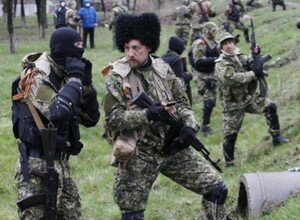 |
|
Illegal armed formations lose the support of the local population in the Donbas Photo http://vesti-ua.net/ |
provoking an internal conflict in the country on political, social, economic, religious or ethnic grounds, as well as stimulation of processes helping its development into mass protests of the population, actions of public unrest, riots and demonstrators' clashes with police;
positioning (appointment) of leaders of protests from representatives of opposition political forces of national or local level, as well as creation of alternative “authorities”;
capture by protesters (including by means of illegal armed groups and security services of the aggressor) of government buildings and important objects of transport and industrial infrastructure, as well as blocking the activity of power structures (including using civilians as “human shields”);
Entry to the country-object of aggression of regular armed forces of the aggressor in the guise of local militias (“self-defense groups”, “militia” and the like) in order to help the opposition and separatists seize power in the state or in its individual regions. At this, is possible hidden participation of the regular armed forces of the aggressor in combat actions on the side of the opponents of the legitimate government of the country-object of aggression;
conducting large-scale information campaigns in support of anti-government forces in the country-object of aggression, and discrediting of its leadership's actions to ensure the constitutional order in the country.
2.3 Third stages — Final
In the final phase (the duration is not limited) the aggressor, consolidating its positions in the country-target of aggression, does the following:
fully supports the new (former opposition) power in the country-object of aggression or the separatist regime in its separate regions (including creation of the authorities and security forces of separatists);
assists in “referendums” in order to determine the direction of internal and external policy of the country-object of aggression, the status of its regions, and such like, as well as in organizing and conducting “elections” of central and local (including separatist) authorities;
promotes legalization of self-proclaimed state entities in the country-object of aggression, delaying the process of resolving the situation on its territory under the guise of mediation in the peace talks. In this case the aggressor country in never admits its role as a party to the conflict;
creates conditions for its military presence in the country-object of aggression on the long/permanent basis (as a “peacekeeping force” or armed separatist groups), as well as for realization of its other, including economic, interests.
Since the second half of the 1990s, elements and technologies of the concept of “hybrid wars” have been applied by Russia in Trans-Dniester, Abkhazia, South Ossetia and Nagorny Karabakh, while the United States, NATO and the EU have used them in Kosovo, Iraq, Libya and Syria. Since the early 2000s, a similar scenario is being actively used by the Russian Federation, also towards Ukraine (within the framework of establishment of Russian control over the post-Soviet territories under the slogan of building a “Russian world”).
3. "Hybrid war" of Russia against Ukraine
The main goal of the Russian Federation in relation to Ukraine is to weaken and decentralize our state, put at the head of the country a pro-Russian government controlled by Russia, to disrupt Ukraine's European course and eventually return Ukraine back under the control of the Russian Federation. At this, the strategy and tactics of Moscow's actions against Ukraine include sequential steps for implementation of the above-mentioned approaches.
3.1 The first stage of the RF-Ukraine war
Thus, at the first (preparatory) stage — from the beginning of the 2000s to mid-2013, such actions included:
during L. Kuchma's second presidential term — strengthening of Russian influence on Ukraine's leadership and taking favorable for Russia decisions. The result of this was the refusal of the Ukrainian authorities to join NATO and the EU (in 2003 after the so-called “Kolchuga” scandal) and “appointment” of Russia's protégé V. Yanukovych as Kuchma's “heir”. However, because of the “orange” revolution, Russia did not reach the desired;
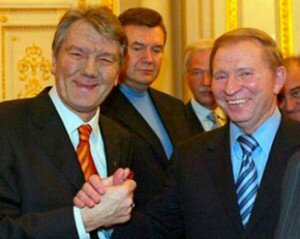 |
|
Strengthening Russian influence on the leadership of Ukraine and realization through it of profitable for Russia decisions Photo http://polittech.org/ |
under the presidency of V. Yushchenko — holding large-scale events to discredit the ideas of the “orange” revolution, and the leadership of Ukraine and its European and Euro-Atlantic course; destabilization of the situation in Ukraine and deepening the split in the Ukrainian society into supporters of the West and supporters of Russia; undermining Ukrainian economy by folding trade and economic relations with the Russian Federation and the use of the energy factor as an instrument of pressure on Ukraine (including within the framework of the so-called “gas wars”). This had become a prerequisite for V. Yanukovych's victory in the presidential election and “unfolding” of the movement vector of our country from west to east;
during the regime of V. Yanukovych — consolidating the gains of the Russian Federation in Ukraine and final reorientation of our state to Russia through: bribery and corruption of the Ukrainian authorities (at the highest level included); penetration of agents of Russian influence into governing bodies of Ukraine; weakening and demoralizing Ukrainian power structures, primarily in the Crimea (chiefs of almost all law enforcement agencies of Ukraine during Yanukovych's regime were citizens of Russia); strengthening Russia's presence in the Ukrainian economy; spreading in our country of ideas of joining the Russian integration initiatives in exchange for loans and economic preferences; building up large-scale pro-Russian movements in Ukraine and its regions (primarily in the Crimean Peninsula and in eastern and southern regions).
The consequence of such Moscow's policy was the refusal of the leadership of Ukraine to sign an Association Agreement with the EU in November 2013 and re-orientation to Russia and the Customs Union, which caused the “Revolution of Dignity”.
Note that the large-scale “zombieing” of both, the Russian society and of a part of the Ukrainian population, based on the ideas of Russian great-power chauvinism has created prerequisites for realization of the next phases (stages) of the “hybrid war” against Ukraine in terms of the annexation of the Crimea and provoking the armed conflict in the east of our country (within the project of creation of a so-called “Novorossia” (“New Russia”).
3.2 The second stage of the RF-Ukraine war
At the second (active) stage — roughly from the beginning of November 2013, the following measures have been taken:
during the period of preparation for the seizure of the Crimea and the further disintegration of Ukraine:
unfolding of a large-scale information campaign to discredit the “Revolution of Dignity” in Ukraine (as a “fascist coup”) and the new authorities of our country (as the “military junta”), and to impose the idea of “the need to protect the Russian-speaking population in the Ukrainian territory”;
organization in the Crimea and eastern Ukraine of so-called “self-defense units” from the local community and the Russian citizens, including officers of special services, military special forces, Cossack and other paramilitary forces;
creation of groups of troops destined for the invasion into the ARC and demonstration of force near the borders of Ukraine under the guise of trainings and ensuring the safety of the Olympic Winter Games in Sochi in January-February 2014.
At this, Russia started its active actions at the Ukrainian territory in the Crimea at the most suitable for itself moment. It was characterized by the weakening of the Ukrainian government because of the objective temporary absence of the president, prime minister and heads of security agencies (hiding in Russia), as well as demoralization of the personnel of Ukrainian law enforcement agencies in the situation of the revolutionary events in our country;
during the annexation of the Crimea:
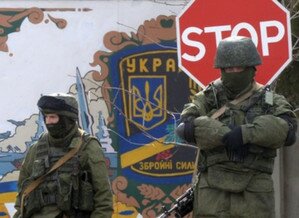 |
|
Russia annexed the Crimea and created conditions for its integration into the Russian Federation Photo http://gordonua.com/ |
seizure by the Russian special services (under the guise of “unknown persons”) of government buildings in Simferopol and removal from power of the leadership of the ARC;
deployment in the Crimea of so-called “self-defense groups” (“little green men”), who took control of the power structures of the Crimean Peninsula and key facilities of its infrastructure, having blocked the units of security agencies of Ukraine in the ARC;
introduction of Russian troops into the Crimea under the guise of military trainings, and under cover of the relevant articles of the Treaty on the Status and Conditions of Russian Federation Black Sea Fleet's Stay on the Territory of Ukraine;
“legalization” of the occupation of the Crimea through “referendum” on the issue of the status of the ARC, and the relevant decision-making by the Parliament and the President of the Russian Federation for the inclusion of the Crimea into Russia as a subject of the Russian Federation;
complete liquidation of the Ukrainian bodies of power in the Crimea, and forcing out of Ukrainian troops from the territory of the Crimean Peninsula.
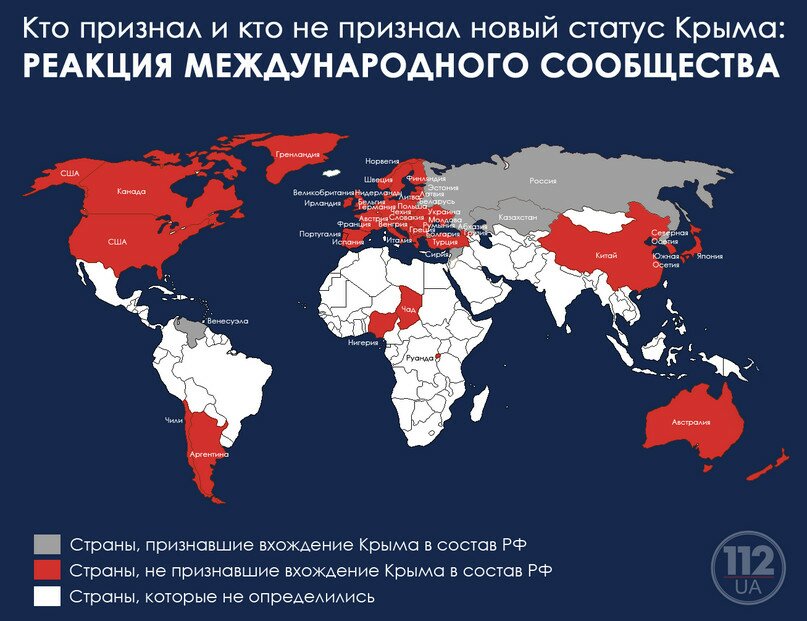
|
|
Russian annexation of the Crimea was not recognized by most of the world Infographics http://112.ua/ |
In this way, Russia annexed the Crimea and created a “base” for its integration into the Russian Federation. At the same time, the Russian annexation of the Crimea was not recognized by the overwhelming majority of countries and caused negative reaction of the USA, the EU and their partners, which imposed sanctions against Russia;
during the creation of the so-called “Novorossia” (“New Russia”) and unleashing the armed conflict in the east of Ukraine:
destabilization of eastern and southern regions of Ukraine by organizing mass anti-government (“Anti-Maydan”) protests and clashes with police and supporters of the unity of Ukraine, as well as seizure of administrative buildings;
implementation of the “Crimean” scenario in the Donetsk and Luhansk regions, using so-called taking control of their territories, forming “groups of militias” from among the representatives of the Russian security services, law enforcement agencies and criminalized local pro-Russian forces;
“legalization” of the so-called Donetsk and Luhansk People's Republics (DPR and LPR) through “referendums” and “elections” of their “authorities”;
Russia's providing of all kinds of support to separatists, including financing their activities, training of militants and providing them with weapons, military equipment and ammunition, as well as deployment of Russian troops on the territory of the DPR and LPR;
the Russian Federation's political and economic pressure on Ukraine, as well as building up of the grouping of the RF Armed Forces near the Ukrainian border;
discrediting of Ukraine's military operation against the Russian-terrorist groups and disintegration of the country, attempts to present the operation as “punitive operation against Ukraine's own population.”
At the same time, Ukraine's active countermeasures to the above-mentioned activities of the Russian Federation, including with the use of military force did not allow to fully implement the “Crimean” scenario in the east of our state. In fact, Russia's “hybrid war” against Ukraine has turned into an armed conflict between them directly involving troops from both sides. Thus, despite the Russians' attempts to hide participation of its armed forces in the conflict, this fact has been recognized by the overwhelming majority of the international community, which has led to the strengthening of the USA and EU's sanctions against Russia.
4. The main conclusions
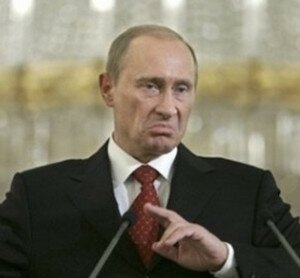 |
|
Russia denies its participation in the conflict. Photo http://prived-net.livejournal.com |
Now the Russian Federation is trying to implement the second phase of the “hybrid war” against Ukraine, and at the same time (since September this year after reaching agreements in Minsk) to perform certain elements of the third phase. For example, the Russian Federation is committed to “freeze” the conflict in the east of Ukraine, forcing us to recognize the separatists as a part of the negotiating process, “and to begin negotiations with them on their (actually — Russian) conditions. In order to do this, Russia is intensifying pressure on Ukraine, including increasing the number of its troops near the Ukrainian border and on our occupied territories. It denies its involvement in the conflict and at the same time is conducting a large-scale information campaign against Ukraine.
Based on the said above, we can conclude that Russia will try to implement its plans both, through continuation of the “hybrid war” (of creeping spread of instability in other Ukrainian regions), and in the form of open aggression with large-scale use of military force.

